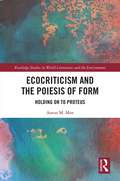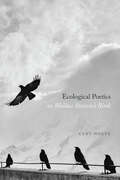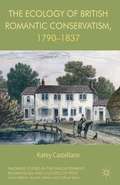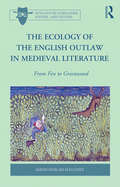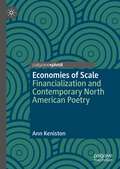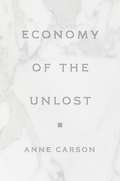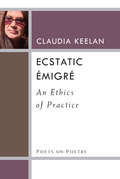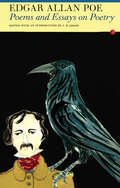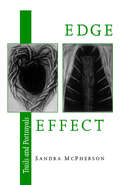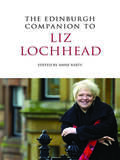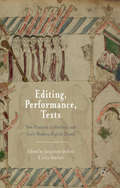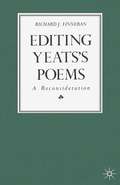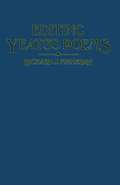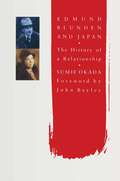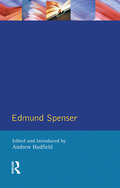- Table View
- List View
Ecocriticism and the Poiesis of Form: Holding on to Proteus (Routledge Studies in World Literatures and the Environment)
by Aaron M. MoeEcocriticism and the Poiesis of Form: Holding on to Proteus demonstrates how a fractal imagination helps one hold the form of a poem within the reaches of Deep Time, and it explores the kinship between the hazy, liminal moment when Sound becomes Syllable and the hazy, liminal moment when the sage energy of the Atom made a leap toward the gaze of the first cell, to echo Merwin. Moe distills his methodology as follows: "My work?—I point," asserted the aphorism. "That’s what I do." To point, the project integrates a wide range of interdisciplinary ideas—including biosemiotics, fractals, phi, trauma theory, the Mandelbrot Set, hyperobjects, meditative chants, Goethe’s morphology, Ramanujan’s summation, a spiderweb’s sonic properties, and Thoreau’s sense of the plant-like burgeoning force of an Atom—in order to open up multiple trajectories. In this context, the volume foregrounds the insights of poets/storytellers including Hillman, Snyder, Anzaldúa, EEC, okpik, Whitman, Dickinson, Gladding, Melville, Morrison, and Toomer, for they are most attentive to that liminal moment when the vibratory hum in language, and in the cosmos, turns kinetic. As this volume draws on a wide range of writers from many backgrounds, it allows the myriad voices to engage with one another across differences in race, gender, and ethnicity. These writers show us how, to echo Dickinson, the "Freight / Of a delivered Syllable - " can split and how the energy unleashed came from, and points us back toward, the energy (un)making the forms of Gaia. The starting point for discussing the energy of a poem can no longer begin with the human; rather, Holding on explores how the poem’s energy is but a sliver of a hyperobject "massively distributed" throughout the cosmos—a sage energy that brings forth form.
Ecological Poetics; or, Wallace Stevens’s Birds
by Cary WolfeThe poems of Wallace Stevens teem with birds: grackles, warblers, doves, swans, nightingales, owls, peacocks, and one famous blackbird who summons thirteen ways of looking. What do Stevens’s evocations of birds, and his poems more generally, tell us about the relationship between human and nonhuman? In this book, the noted theorist of posthumanism Cary Wolfe argues for a philosophical and theoretical reinvention of ecological poetics, using Stevens as a test case. Stevens, Wolfe argues, is an ecological poet in the sense that his places, worlds, and environments are co-created by the life forms that inhabit them. Wolfe argues for a “nonrepresentational” conception of ecopoetics, showing how Stevens’s poems reward study alongside theories of system, environment, and observation derived from a multitude of sources, from Ralph Waldo Emerson and Niklas Luhmann to Jacques Derrida and Stuart Kauffman. Ecological Poetics is an ambitious interdisciplinary undertaking involving literary criticism, contemporary philosophy, and theoretical biology.
Ecological Poetics; or, Wallace Stevens’s Birds
by Cary WolfeThe poems of Wallace Stevens teem with birds: grackles, warblers, doves, swans, nightingales, owls, peacocks, and one famous blackbird who summons thirteen ways of looking. What do Stevens’s evocations of birds, and his poems more generally, tell us about the relationship between human and nonhuman? In this book, the noted theorist of posthumanism Cary Wolfe argues for a philosophical and theoretical reinvention of ecological poetics, using Stevens as a test case. Stevens, Wolfe argues, is an ecological poet in the sense that his places, worlds, and environments are co-created by the life forms that inhabit them. Wolfe argues for a “nonrepresentational” conception of ecopoetics, showing how Stevens’s poems reward study alongside theories of system, environment, and observation derived from a multitude of sources, from Ralph Waldo Emerson and Niklas Luhmann to Jacques Derrida and Stuart Kauffman. Ecological Poetics is an ambitious interdisciplinary undertaking involving literary criticism, contemporary philosophy, and theoretical biology.
Ecological Poetics; or, Wallace Stevens’s Birds
by Cary WolfeThe poems of Wallace Stevens teem with birds: grackles, warblers, doves, swans, nightingales, owls, peacocks, and one famous blackbird who summons thirteen ways of looking. What do Stevens’s evocations of birds, and his poems more generally, tell us about the relationship between human and nonhuman? In this book, the noted theorist of posthumanism Cary Wolfe argues for a philosophical and theoretical reinvention of ecological poetics, using Stevens as a test case. Stevens, Wolfe argues, is an ecological poet in the sense that his places, worlds, and environments are co-created by the life forms that inhabit them. Wolfe argues for a “nonrepresentational” conception of ecopoetics, showing how Stevens’s poems reward study alongside theories of system, environment, and observation derived from a multitude of sources, from Ralph Waldo Emerson and Niklas Luhmann to Jacques Derrida and Stuart Kauffman. Ecological Poetics is an ambitious interdisciplinary undertaking involving literary criticism, contemporary philosophy, and theoretical biology.
Ecological Poetics; or, Wallace Stevens’s Birds
by Cary WolfeThe poems of Wallace Stevens teem with birds: grackles, warblers, doves, swans, nightingales, owls, peacocks, and one famous blackbird who summons thirteen ways of looking. What do Stevens’s evocations of birds, and his poems more generally, tell us about the relationship between human and nonhuman? In this book, the noted theorist of posthumanism Cary Wolfe argues for a philosophical and theoretical reinvention of ecological poetics, using Stevens as a test case. Stevens, Wolfe argues, is an ecological poet in the sense that his places, worlds, and environments are co-created by the life forms that inhabit them. Wolfe argues for a “nonrepresentational” conception of ecopoetics, showing how Stevens’s poems reward study alongside theories of system, environment, and observation derived from a multitude of sources, from Ralph Waldo Emerson and Niklas Luhmann to Jacques Derrida and Stuart Kauffman. Ecological Poetics is an ambitious interdisciplinary undertaking involving literary criticism, contemporary philosophy, and theoretical biology.
Ecological Poetics; or, Wallace Stevens’s Birds
by Cary WolfeThe poems of Wallace Stevens teem with birds: grackles, warblers, doves, swans, nightingales, owls, peacocks, and one famous blackbird who summons thirteen ways of looking. What do Stevens’s evocations of birds, and his poems more generally, tell us about the relationship between human and nonhuman? In this book, the noted theorist of posthumanism Cary Wolfe argues for a philosophical and theoretical reinvention of ecological poetics, using Stevens as a test case. Stevens, Wolfe argues, is an ecological poet in the sense that his places, worlds, and environments are co-created by the life forms that inhabit them. Wolfe argues for a “nonrepresentational” conception of ecopoetics, showing how Stevens’s poems reward study alongside theories of system, environment, and observation derived from a multitude of sources, from Ralph Waldo Emerson and Niklas Luhmann to Jacques Derrida and Stuart Kauffman. Ecological Poetics is an ambitious interdisciplinary undertaking involving literary criticism, contemporary philosophy, and theoretical biology.
Ecological Poetics; or, Wallace Stevens’s Birds
by Cary WolfeThe poems of Wallace Stevens teem with birds: grackles, warblers, doves, swans, nightingales, owls, peacocks, and one famous blackbird who summons thirteen ways of looking. What do Stevens’s evocations of birds, and his poems more generally, tell us about the relationship between human and nonhuman? In this book, the noted theorist of posthumanism Cary Wolfe argues for a philosophical and theoretical reinvention of ecological poetics, using Stevens as a test case. Stevens, Wolfe argues, is an ecological poet in the sense that his places, worlds, and environments are co-created by the life forms that inhabit them. Wolfe argues for a “nonrepresentational” conception of ecopoetics, showing how Stevens’s poems reward study alongside theories of system, environment, and observation derived from a multitude of sources, from Ralph Waldo Emerson and Niklas Luhmann to Jacques Derrida and Stuart Kauffman. Ecological Poetics is an ambitious interdisciplinary undertaking involving literary criticism, contemporary philosophy, and theoretical biology.
The Ecology of British Romantic Conservatism, 1790-1837 (Palgrave Studies in the Enlightenment, Romanticism and Cultures of Print)
by Katey CastellanoAnalyzing Romantic conservative critiques of modernity found in literature, philosophy, natural history, and agricultural periodicals, this book finds a common theme in the 'intergenerational imagination.' This impels an environmental ethic in which obligations to past and future generations shape decisions about inherited culture and land.
The Ecology of the English Outlaw in Medieval Literature: From Fen to Greenwood (Outlaws in Literature, History, and Culture)
by Sarah Harlan-HaugheyArguing that outlaw narratives become particularly popular and poignant at moments of national ecological and political crisis, Sarah Harlan-Haughey examines the figure of the outlaw in Anglo-Saxon poetry and Old English exile lyrics such as Beowulf, works dealing with the life and actions of Hereward, the Anglo-Norman romance of Fulk Fitz Waryn, the Robin Hood ballads, and the Tale of Gamelyn. Although the outlaw's wilderness shelter changed dramatically from the menacing fens and forests of Anglo-Saxon England to the bright, known, and mapped greenwood of the late outlaw romances and ballads, Harlan-Haughey observes that the outlaw remained strongly animalistic, other, and liminal. His brutality points to a deep literary ambivalence towards wilderness and the animal, at the same time that figures such as the Anglo-Saxon resistance fighter Hereward, the brutal yet courtly Gamelyn, and Robin Hood often represent a lost England imagined as pristine and forested. In analyzing outlaw literature as a form of nature writing, Harlan-Haughey suggests that it often reveals more about medieval anxieties respecting humanity's place in nature than it does about the political realities of the period.
The Ecology of the English Outlaw in Medieval Literature: From Fen to Greenwood (Outlaws in Literature, History, and Culture)
by Sarah Harlan-HaugheyArguing that outlaw narratives become particularly popular and poignant at moments of national ecological and political crisis, Sarah Harlan-Haughey examines the figure of the outlaw in Anglo-Saxon poetry and Old English exile lyrics such as Beowulf, works dealing with the life and actions of Hereward, the Anglo-Norman romance of Fulk Fitz Waryn, the Robin Hood ballads, and the Tale of Gamelyn. Although the outlaw's wilderness shelter changed dramatically from the menacing fens and forests of Anglo-Saxon England to the bright, known, and mapped greenwood of the late outlaw romances and ballads, Harlan-Haughey observes that the outlaw remained strongly animalistic, other, and liminal. His brutality points to a deep literary ambivalence towards wilderness and the animal, at the same time that figures such as the Anglo-Saxon resistance fighter Hereward, the brutal yet courtly Gamelyn, and Robin Hood often represent a lost England imagined as pristine and forested. In analyzing outlaw literature as a form of nature writing, Harlan-Haughey suggests that it often reveals more about medieval anxieties respecting humanity's place in nature than it does about the political realities of the period.
Economies of Scale: Financialization and Contemporary North American Poetry (Palgrave Studies in Literature, Culture and Economics)
by Ann KenistonThis book offers the first sustained study of the ways 21st century North American poems engage with financialization. It argues that recent poems about economics not only discuss but enact concerns with containment and agency essential to the contemporary financialized economy by manipulating the seemingly old-fashioned figures of synecdoche (the representation of the whole by the part) and prosopopeia or personification. Its four body chapters offer in-depth readings of the work of eleven formally, culturally, and thematically diverse contemporary U.S. and Canadian poets who variously consider labor, consumerism, debt, and the derivative form; the Coda reads several recent poems about reparations in terms of an emerging tendency to emphasize the historical, racialized, and ethical contexts of contemporary economics. As the book explores financialization’s representation in recent poetry, it redresses arguments that poetry is irrelevant to contemporary culture.
Economy of the Unlost: (Reading Simonides of Keos with Paul Celan)
by Anne CarsonThe ancient Greek lyric poet Simonides of Keos was the first poet in the Western tradition to take money for poetic composition. From this starting point, Anne Carson launches an exploration, poetic in its own right, of the idea of poetic economy. She offers a reading of certain of Simonides' texts and aligns these with writings of the modern Romanian poet Paul Celan, a Jew and survivor of the Holocaust, whose "economies" of language are notorious. Asking such questions as, What is lost when words are wasted? and Who profits when words are saved? Carson reveals the two poets' striking commonalities. In Carson's view Simonides and Celan share a similar mentality or disposition toward the world, language and the work of the poet. Economy of the Unlost begins by showing how each of the two poets stands in a state of alienation between two worlds. In Simonides' case, the gift economy of fifth-century b.c. Greece was giving way to one based on money and commodities, while Celan's life spanned pre- and post-Holocaust worlds, and he himself, writing in German, became estranged from his native language. Carson goes on to consider various aspects of the two poets' techniques for coming to grips with the invisible through the visible world. A focus on the genre of the epitaph grants insights into the kinds of exchange the poets envision between the living and the dead. Assessing the impact on Simonidean composition of the material fact of inscription on stone, Carson suggests that a need for brevity influenced the exactitude and clarity of Simonides' style, and proposes a comparison with Celan's interest in the "negative design" of printmaking: both poets, though in different ways, employ a kind of negative image making, cutting away all that is superfluous. This book's juxtaposition of the two poets illuminates their differences--Simonides' fundamental faith in the power of the word, Celan's ultimate despair--as well as their similarities; it provides fertile ground for the virtuosic interplay of Carson's scholarship and her poetic sensibility.
Economy of the Unlost: (Reading Simonides of Keos with Paul Celan)
by Anne CarsonThe ancient Greek lyric poet Simonides of Keos was the first poet in the Western tradition to take money for poetic composition. From this starting point, Anne Carson launches an exploration, poetic in its own right, of the idea of poetic economy. She offers a reading of certain of Simonides' texts and aligns these with writings of the modern Romanian poet Paul Celan, a Jew and survivor of the Holocaust, whose "economies" of language are notorious. Asking such questions as, What is lost when words are wasted? and Who profits when words are saved? Carson reveals the two poets' striking commonalities. In Carson's view Simonides and Celan share a similar mentality or disposition toward the world, language and the work of the poet. Economy of the Unlost begins by showing how each of the two poets stands in a state of alienation between two worlds. In Simonides' case, the gift economy of fifth-century b.c. Greece was giving way to one based on money and commodities, while Celan's life spanned pre- and post-Holocaust worlds, and he himself, writing in German, became estranged from his native language. Carson goes on to consider various aspects of the two poets' techniques for coming to grips with the invisible through the visible world. A focus on the genre of the epitaph grants insights into the kinds of exchange the poets envision between the living and the dead. Assessing the impact on Simonidean composition of the material fact of inscription on stone, Carson suggests that a need for brevity influenced the exactitude and clarity of Simonides' style, and proposes a comparison with Celan's interest in the "negative design" of printmaking: both poets, though in different ways, employ a kind of negative image making, cutting away all that is superfluous. This book's juxtaposition of the two poets illuminates their differences--Simonides' fundamental faith in the power of the word, Celan's ultimate despair--as well as their similarities; it provides fertile ground for the virtuosic interplay of Carson's scholarship and her poetic sensibility.
Ecstatic Émigré: An Ethics of Practice (Poets On Poetry)
by Claudia KeelanMost think of an émigré as one who leaves her native land to find home in another. Claudia Keelan, in essays both personal and critical, enlists poetic company for her journey, engaging both canonical and common figures, from Gertrude Stein to a prophetic Las Vegas cab driver named Caesar. Mapping her own peripatetic evolution in poetry and her nomadic life, she also engages with Christian and Buddhist doctrines on the virtues of dispossession. ? Ecstatic Émigré pays homage to poets from Thoreau and Whitman to Alice Notley, all of whom share a commitment to living and writing in the moment. Keelan asks the same questions about the growth of flowers or the meaning of bioluminescence as she does about the poetics of John Cage or George Oppen. Her originality is grounded by the ways in which she connects poetic principles with the spiritual concepts of via negativa demonstrated both in St. John of the Cross and Mahayana Buddhism. In addition, her essays demonstrate an activist spirit and share a commitment to the passive resistance demonstrated in Martin Luther King, Jr.’s concept of the “beloved community” and philosopher Simone Weil’s dedication to “exile.”
Edexcel GCSE English Literature 2015 Poetry Anthology (PDF)
by NAThe Pearson Edexcel GCSE (9-1) English Literature Poetry Anthology should be used to prepare for Component 2 of your assessment.
Edexcel International GCSE: English Anthology (PDF)
by EdexcelANTHOLOGY Pearson Edexcel International GCSE English Anthology for use with: Edexcel International GCSE in English Literature (4ET1) Edexcel International GCSE in English Language (Specification A) (4EA1)
Edgar Allan Poe: Selected Poems and Essays
by Edgar Allan PoeHis reputation has never settled, seeing as many reversals after his death as during his life. Though read and enjoyed ny many, fewer admire him openly. This volume includes all of his poetry and his most important essays.
Edgar Allan Poe: Selected Poems and Essays
by Edgar Allan PoeHis reputation has never settled, seeing as many reversals after his death as during his life. Though read and enjoyed ny many, fewer admire him openly. This volume includes all of his poetry and his most important essays.
Edge Effect: Trails and Portrayals (pdf) (Wesleyan Poetry Series)
by Sandra McPhersonEdge Effect is Sandra McPherson's most original work to date. Constructed in two parts, the collection embraces secretly related worlds: the poetics of natural history and artistic discoveries of self-taught folk artists. Throughout, waves from one poem mark the shores of others. In natural history, an edge effect occurs where two communities, such as land and sea, overlap, that zone becoming more diversified than each of them. McPherson explores this effect in nature and art, questioning our notions of inside and outside, center and margin. Profound and moving, she recasts the very premises of formal understanding in poetry, accommodating at once the arts of nature and the nature of art.
The Edinburgh Companion to Liz Lochhead
by Anne VartyExplores the significance of Liz Lochhead's work for the twenty-first century.The first contemporary critical investigation since Liz Lochhead's appointment as Scotland's second Scots Makar, this Companion examines her poetry, theatre, visual and performing arts, and broadcast media. It also discusses her theatre for children and young people, her translations for the stage as well as translations of her texts into foreign languages and cultures.Several poets offer commentaries on the influence of Liz Lochhead on their own practice while academic critics from America, Europe, England and Scotland offer new critical readings inspired by feminism, post-colonialism and cultural history. The volume addresses all of Lochhead's major outputs, from new appraisal of early work such as Dreaming Frankenstein and Blood and Ice to evaluations of her more recent works and collections such as The Colour of Black and White and Perfect Days. Key Features:* Critical perspectives on Lochhead's established work and most recent interventions.* Situates Lochhead at the forefront of developing Scottish culture in a global context* Provides a bibliography of Lochhead's works and a select bibliography of criticismKeywords: Liz Lochhead, Scottish Poetry, Scottish Theatre, Women's Writing, Dreaming Frankenstein, National Makar
Editing, Performance, Texts: New Practices in Medieval and Early Modern English Drama
by Julie Sanders Jacqueline JenkinsThe essays in this volume challenge current 'givens' in medieval and early modern research around periodization and editorial practice. They showcase cutting-edge research practices and approaches in textual editing, and in manuscript and performance studies to produce new ways of reading and working for students and scholars.
Editing Yeats’s Poems: A Reconsideration
by Richard J FinneranThis study is a companion to the revised edition of W.B.Yeats, The Poems: A New Edition. Professor Finneran outlines the complex problems facing an editor of Yeats's poetry and explains the solutions adopted in the new text. Manuscript materials are drawn on extensively, including some which have recently come to light in the Scribner Archives at the University of Texas and at Princeton University. Compared with the first edition of this volume (Editing Yeats's Poems, 1983), there is an additional chapter - on the order of the poems - as well as new information on the Scribner Edition and other revisions throughout.
Edmund Spenser
by Andrew HadfieldThis collection represents some of the best recent critical writing on Edmund Spenser, a major Renaissance English poet. The essays cover the whole of Spensers work, from early literary experiments such as The Shepeardes Calendar, to his unfinished crowning work,The Fairie Queene. The introduction provides an overview of critical responses to Spenser, setting his work and the debates which it has generated in their perspective contexts: new historicist, post-structural, psychoanalytic and feminist. His study also covers the critical responses of leading British, Irish and American scholars.
